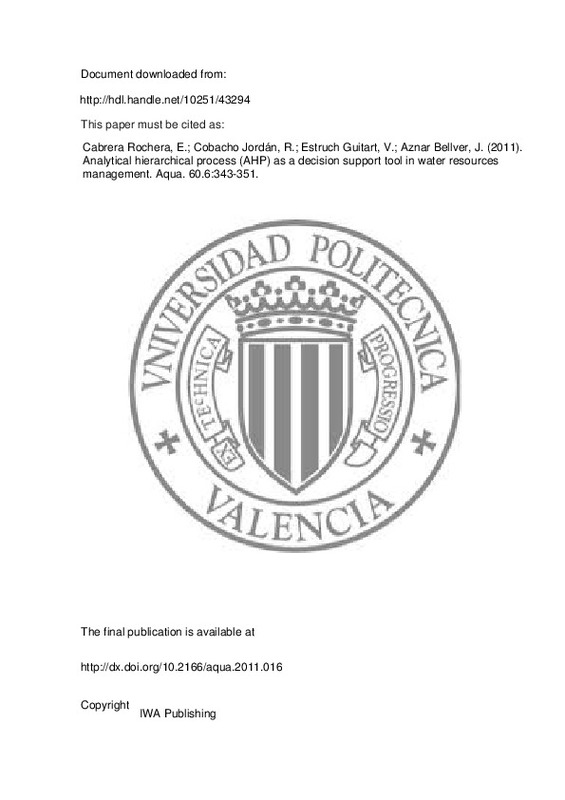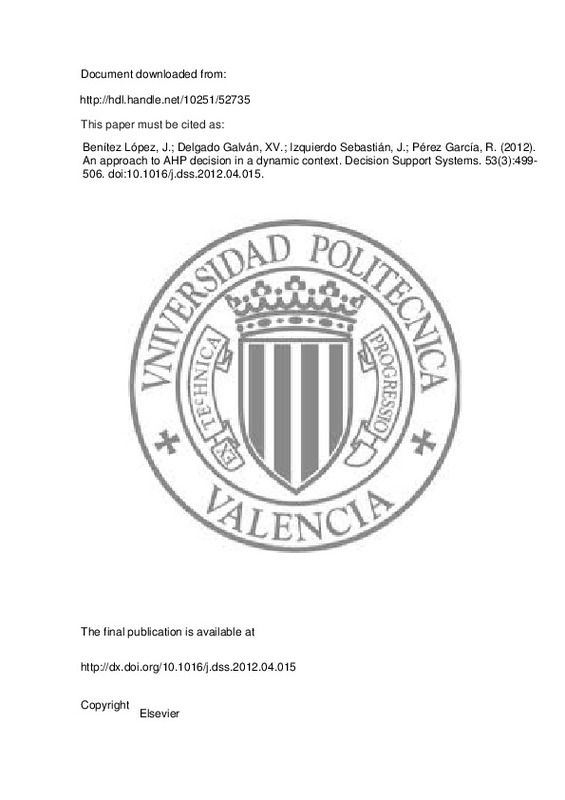JavaScript is disabled for your browser. Some features of this site may not work without it.
Buscar en RiuNet
Listar
Mi cuenta
Estadísticas
Ayuda RiuNet
Admin. UPV
How to make the last decision at a closing company. Decision making process & analytic hierarchy process. A case study
Mostrar el registro sencillo del ítem
Ficheros en el ítem
| dc.contributor.advisor | Magnusson, Thomas
|
es_ES |
| dc.contributor.author | Camacho Fantoba, Evelyn
|
es_ES |
| dc.date.accessioned | 2015-10-14T12:12:05Z | |
| dc.date.available | 2015-10-14T12:12:05Z | |
| dc.date.created | 2015-09 | |
| dc.date.issued | 2015-10-14 | |
| dc.identifier.uri | http://hdl.handle.net/10251/55960 | |
| dc.description.abstract | Consulta en la Biblioteca ETSI Industriales (Riunet) | es_ES |
| dc.description.abstract | [EN] In our competitive world, companies face high-pressure business situations, such as greater quality products offered by competitors and dynamic environment evolution. This requires careful scrutinizing of every single step of the decision-making process. Inside an enterprise all decisions made usually follow a pattern, but when a company is near closure, certain crucial factors become even more significant. That leads to the decision-making process acquiring a somewhat new role. At this stage of closure, stakeholders, professional preferences and business information (e.g. background data and expected forecasts) become fundamental criteria, which could enable a change of a firm’s business direction. On that basis, this report’s purpose is described as follows: The purpose of this report is to analyse the significance of the decision-making process to make the most profitable decision at a closing of a company. According with previous literature on this subject there are four main aspects which affect the decision-making process: a) decision effectiveness and learning environment, b) decision maker’s positive skills, c) bad habits in decision procedures and d) the relationship between decision-makers and leadership. This theoretical information was used in order to analyse the studied company’s decision development and the CEO’s performance. Based on an interviews agenda, the studied company’s evolution was analysed, which made it possible to create a current-event’s timeline and a definition of the state of the firm. Once current events were defined and connected to theoretical framework, based on interviews with the CEO, the technicians and secretaries’ interviews, it was possible to build a Closure Options’ Decision Tree. This tool is quite common in business environments and in this case, it was formed by five decision criteria and four different purchasing options. When all previous information was assessed, the Analytic Hierarchy Process followed: a simple but effective tool used to rank criteria and alternatives in order to get the most suitable option for the studied company’s future. In this tough decision, The Analytic Hierarchy Process produced a solution, which in the end was the one executed. Based on these results, it can be concluded that The Decision Making Process must be seriously regarded from the very beginning of the decision process, since it plays a key role in decision effectiveness. The decision makers must take into account the rest of stakeholders, take care of multiple business factors, lay aside personal prejudices, interests or hunches, try to consider as much information as possible and build a Feedback’s Virtuous Circle (a basis in learning environment). The Analytic Hierarchy Process is a trustworthy tool, which presents options to decision makers when a complex situation arises in their career. | es_ES |
| dc.language | Español | es_ES |
| dc.publisher | Universitat Politècnica de València | es_ES |
| dc.rights | Reserva de todos los derechos | es_ES |
| dc.subject | Consulta en la Biblioteca ETSI Industriales | es_ES |
| dc.subject | Toma de decisiones | es_ES |
| dc.subject | Procesos analíticos | es_ES |
| dc.subject | Decision Making Proces | es_ES |
| dc.subject | Analytic Hierarchy Process | es_ES |
| dc.subject | Closing Company | es_ES |
| dc.subject | Decision Effectiveness | es_ES |
| dc.subject | Learning Environment | es_ES |
| dc.subject | Positive Skills | es_ES |
| dc.subject | Bad Habits | es_ES |
| dc.subject | Decision Maker | es_ES |
| dc.subject | Leader | es_ES |
| dc.subject.classification | ORGANIZACION DE EMPRESAS | es_ES |
| dc.subject.other | Ingeniero de Organización Industrial-Enginyer d'Organització Industrial | es_ES |
| dc.title | How to make the last decision at a closing company. Decision making process & analytic hierarchy process. A case study | es_ES |
| dc.type | Proyecto/Trabajo fin de carrera/grado | es_ES |
| dc.rights.accessRights | Cerrado | es_ES |
| dc.contributor.affiliation | Universitat Politècnica de València. Escuela Técnica Superior de Ingenieros Industriales - Escola Tècnica Superior d'Enginyers Industrials | es_ES |
| dc.description.bibliographicCitation | Camacho Fantoba, E. (2015). How to make the last decision at a closing company. Decision making process & analytic hierarchy process. A case study. http://hdl.handle.net/10251/55960. | es_ES |
| dc.description.accrualMethod | Archivo delegado | es_ES |
Este ítem aparece en la(s) siguiente(s) colección(ones)
-
ETSII - Trabajos académicos [10404]
Escuela Técnica Superior de Ingenieros Industriales




![[Cerrado]](/themes/UPV/images/candado.png)



